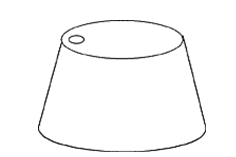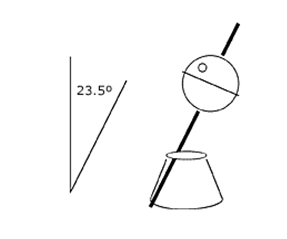Distance Learning Module: Seasons, Equinoxes, and Solstices
This Saturday—June 20, 2020—marks the official beginning of summer in the Northern Hemisphere, with the occurrence of the June solstice. In celebration, we’re focusing this week’s Distance Learning offerings on seasons. Today we’ll revisit a previous lesson about what causes the Earth’s seasons—with bonus content added to focus on the solstices!
Read It
What is a Season?
Earth is in constant motion. Approximately every 365 days, our planet completes one revolution around the Sun: a year. Every 24 hours, Earth completes one rotation on its own axis: a day. Earth's axis (the imaginary line running from the North Pole to the South Pole) is not straight up-and-down. It is tilted about 23.5 degrees. This means that sunlight hits different parts of the Earth’s surface at different angles throughout the year. Seasons are the result of the tilt of Earth's axis and its place in orbit.
A common misunderstanding for the seasons is that Earth is closer to the Sun during the summer, and farther away in the winter. Actually, the opposite is true in our part of the world! Seasons are caused by Earth's axial tilt, not its distance from the Sun. During the time of year that we call summer in the Northern Hemisphere, the north pole of Earth's axis is pointed toward the Sun. This means that sunlight strikes the Northern Hemisphere at a more direct angle, creating warmer weather. It’s true that Earth’s orbit around the Sun is elliptical—meaning that we go around the Sun in more of an oval than a perfectly circular path—so the Earth moves closer to and farther from the Sun at certain points in its orbit. But our distance from the Sun actually has little effect on the onset of seasons: Earth is at its Perihelion—the closest point to the Sun—when it is winter in the Northern Hemisphere.
Another factor relating to weather and the seasons is he length of time the Sun spends above the horizon. In June, the Sun rises high in the sky over the Northern Hemisphere, and stays above the horizon in the United States for as long as 15 hours. Thus, the Sun not only heats us with more direct rays, but it also has more time to do it each day.
What is an Equinox?
Two days out of the year, we experience an equinox, when the Earth is tilted neither toward nor away from the Sun. This happens because the Earth’s axis falls exactly parallel to the plane of its orbit around the Sun. On these dates, the Sun directly over the equator at mid-day. During an equinox, the hours of daylight and the hours of darkness are about equal almost everywhere on Earth (hence, the name).
The March (vernal) equinox marks the beginning of spring in the Northern Hemisphere. After this date, the days start to become longer and the nights become shorter. The opposite is happening in the Southern Hemisphere, where the March equinox marks the beginning of autumn. In 2020, the vernal equinox occurred on the night of March 19—making March 20 the first day of spring.
The September (autumnal) equinox is the beginning of autumn (fall) in the Northern Hemisphere. After the autumnal equinox, the days become shorter, the nights become longer, and our weather begins to cool. The opposite is happening in the Southern Hemisphere, where the days start getting longer, the weather warms, and the September equinox signals the beginning of spring.
What is a Solstice?
On two other days of the year, we experience a solstice. At the solstice, the tilt of Earth toward the Sun is at a maximum angle in one hemisphere and a minimum angle in the other.
The December solstice occurs around December 20 or 21. In the Northern Hemisphere, the North Pole is tilted about 23.4° away from the Sun, making this the shortest day of the year and the official start of winter. The opposite occurs in the Southern Hemisphere, where the December solstice is the longest day of the year and the first day of summer.
0n the june solstice, the sun shines more directly on the northern hemisphere: the days become longer, the weather is warmer, and the beginning of summer has arrived (image courtesy nasa/wikimedia commons)
The June solstice occurs around June 20 or 21. This year, the solstice will occur on Saturday, June 20, 2020. In the Northern Hemisphere, the North Pole is tilted about 23.4° toward the Sun, making the June solstice the longest day of the year and the beginning of summer. In the Southern Hemisphere, this will be the shortest day and the start of winter.
view of the june solstice from space (image credit: Noaa)
Try It
Hands-On Activity: Modeling the Seasons (adapted from an activity designed by the Exploratorium, San Francisco)
Materials
flashlight
a room that can be made dark
a Styrofoam ball (in a real pinch, a fresh orange or a rounded sphere of Play-Doh will do, but it won’t be completely spherical!)
a large drinking straw
a rubber band
a flexible plastic cup
Scotch tape
scissors
Make a Model of the Earth
Push the straw through the center of the Styrofoam ball. This represents the axis about which the earth rotates. One end of the ball is north and the other end is south. Place a rubber band around the center of the ball to represent the equator.
Place the tack or sticky dot into the ball at an appropriate location on the ball to represent your town or city. (For instance, the latitude of Concord, New Hampshire is about 43.2˚ north, so you’d place the tack not quite halfway between the equator and the North Pole.)
With an adult’s help, use the scissors to make a hole in the bottom of the plastic cup, near the side, as shown below. It should be just large enough to accommodate the diameter of the straw.
Cut a long (approx. 8 cm) piece of tape. Cut a second, shorter piece (approx. 2 cm) and place it in the center of the long piece, with the sticky sides together. Place the straw into the hole in the cup. The smooth part of the small tape should allow the straw to rotate in the hole, while the sticky parts of the long tape will hold it in place against the side of the cup. Your model should look something like the picture on the left. Use a protractor to check the angle of the earth’s tilt. It should be 23.5 degrees.
Set up the “Solar System”
Enter the room that is designated to represent outer space. Choose a small object and put it in a stationary location to represent Polaris, the North Star. Your straw should point to Polaris throughout the activity.Set up the flashlight (Sun) in the center of the room, and darken the rest of the room.
Model a Day on Earth
Turn the straw so that the earth spins counterclockwise (when viewed from the north) for one rotation. Notice that the dot is in light (day) for about half of the rotation and is in shadow (night) for about half of the rotation.
Model the Seasons
Station yourself at four different locations around the Sun, to represent the changing of the seasons on December 21, March 21, June 21, and September 21. Your movement should look like this if seen from above:
From each location (date), spin the Earth on its axis (rotate the straw in its hole in the drinking cup) to simulate one day. Make observations about the following:
For what fraction of the day is the dot in the light? More than half? Less than half? About half?
For what fraction of the day is the North Pole in the light?
How is the light from the sun striking the dot? Is it direct or at an angle?
What is happening in the Southern Hemisphere, versus in the Northern Hemisphere?
When you have been to each of the four dates, have modeled one year on Earth (one revolution around the Sun)!
What’s Going On?
Many people think the seasons are caused by variations in our distance from the Sun. While the Earth’s orbit is slightly elliptical, it’s very close to circular, and the variation in distance between the Earth and Sun is not enough to account for our seasons. The seasons are caused by the tilt of the earth. The earth holds its rotation axis (tilt) fixed in space as it moves around the Sun. In the summer, the Northern Hemisphere tilts toward the Sun. It’s warmer because the midday sun shines more directly head-on. In the winter, when the Northern Hemisphere tilts away from the Sun, the Sun’s rays strike the Earth at a lower angle, and the energy from the sunlight is spread out over a larger area, which reduces its effectiveness at heating the ground. The way the Sun hits the Earth is opposite between the Northern and Southern Hemispheres—so the seasons are reversed between the two halves of the Earth.









